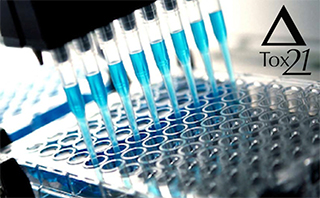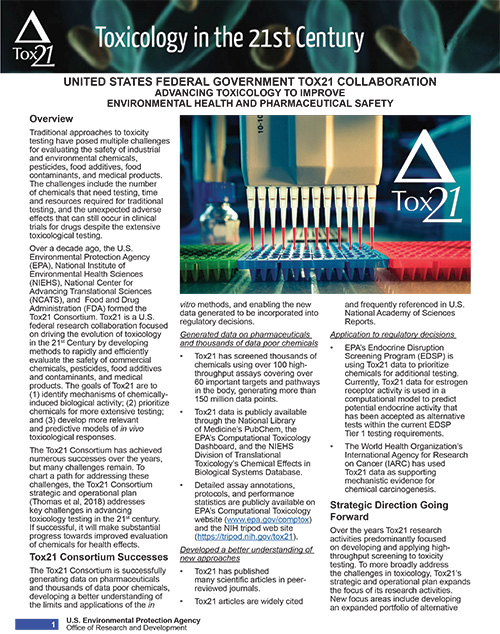
Tox21 is a research collaboration of four U.S. federal agencies: National Institute of Environmental Health Sciences (NIEHS) Division of Translational Toxicology (DTT), National Center for Advancing Translational Sciences (NCATS), Food and Drug Administration (FDA), and Environmental Protection Agency (EPA).
The partnership formed in 2008 in response to concerns that traditional approaches to toxicology testing could not keep pace with a rapidly growing list of industrial and environmental chemicals, pesticides, food additives, food contaminants, and medical products. Advocates called for a new approach that transformed toxicology from an observational science that monitored the effects of chemicals to a predictive discipline that better forecasts chemical toxicity and effects on human health.
The Tox21 program has been guided by a series of important vision and planning reports. Toxicology in the 21st Century: The Role of the National Toxicology Program (2004) and National Toxicology Program for the 21st Century: A Roadmap for the Future (2004) established a foundation for the collaboration. Toxicity Testing in the 21st Century: A Vision and a Strategy (2007) created a three-phase program to develop and expand a library of chemical testing results.
A more recent document — The U.S. Federal Tox21 Program: A Strategic and Operational Plan for Continued Leadership (2018) — expanded the focus of its research activities. It challenged the partnership to develop alternative test systems that are predictive of human toxicity, address technical limitations in in vitro test systems, curate legacy animal (in vivo) toxicity testing data, establish scientific confidence in new approach methodologies (NAMs) and in vitro test systems, and refine alternative methods for characterizing pharmacokinetics and disposition in in vitro assays.
For more about the history of Tox21, see about Tox21.
Goals of the Tox21 Program
- Contribute to the reduction, refinement, and replacement (3Rs) of animal use in toxicity testing and support development of NAMs.
- Develop more relevant and predictive models of in vivo toxicological responses.
- Identify mechanisms of chemically induced biological activity.
- Prioritize chemicals for more extensive testing.
- Reduce time, effort, and costs associated with toxicology testing.
Tox21 Consortium Fact Sheet

The Tox21 Fact Sheet offers a summary of the program, highlights key successes and translational applications, and presents an overview of the consortium’s strategic direction as the science continues to evolve.


